ESP SKODA YETI 2014 1.G / 5L Workshop Manual
[x] Cancel search | Manufacturer: SKODA, Model Year: 2014, Model line: YETI, Model: SKODA YETI 2014 1.G / 5LPages: 248, PDF Size: 29.49 MB
Page 217 of 248
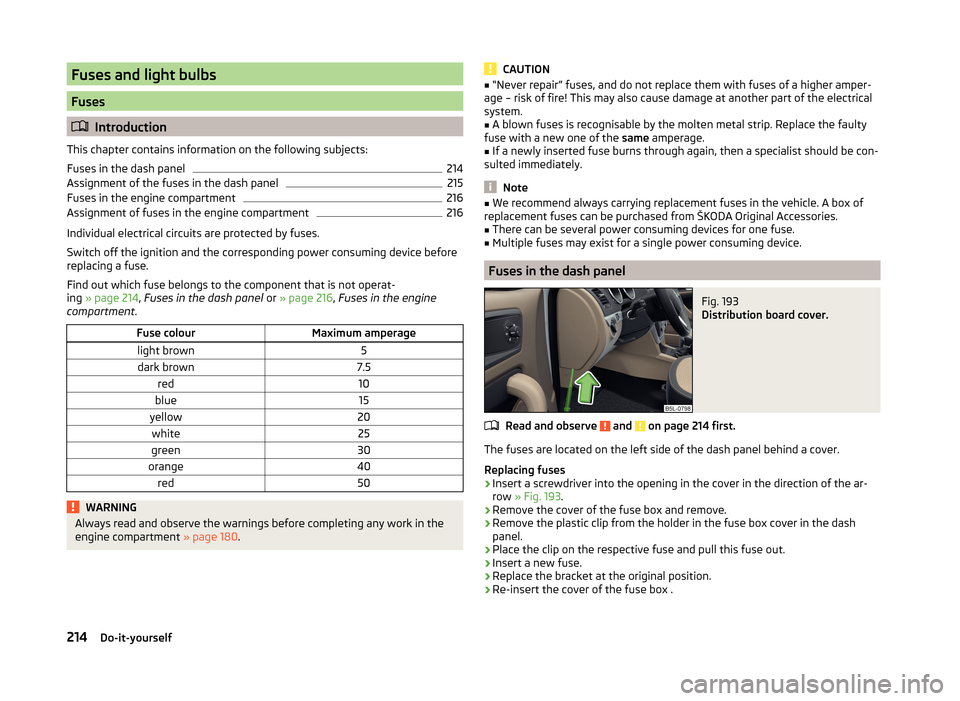
Fuses and light bulbs
Fuses
Introduction
This chapter contains information on the following subjects:
Fuses in the dash panel
214
Assignment of the fuses in the dash panel
215
Fuses in the engine compartment
216
Assignment of fuses in the engine compartment
216
Individual electrical circuits are protected by fuses.
Switch off the ignition and the corresponding power consuming device before
replacing a fuse.
Find out which fuse belongs to the component that is not operat-
ing » page 214 , Fuses in the dash panel or » page 216 , Fuses in the engine
compartment .
Fuse colourMaximum amperagelight brown5dark brown7.5red10blue15yellow20white25green30orange40red50WARNINGAlways read and observe the warnings before completing any work in the
engine compartment » page 180.CAUTION■
“Never repair” fuses, and do not replace them with fuses of a higher amper-
age – risk of fire! This may also cause damage at another part of the electrical
system.■
A blown fuses is recognisable by the molten metal strip. Replace the faulty
fuse with a new one of the same amperage.
■
If a newly inserted fuse burns through again, then a specialist should be con-
sulted immediately.
Note
■ We recommend always carrying replacement fuses in the vehicle. A box of
replacement fuses can be purchased from ŠKODA Original Accessories.■
There can be several power consuming devices for one fuse.
■
Multiple fuses may exist for a single power consuming device.
Fuses in the dash panel
Fig. 193
Distribution board cover.
Read and observe and on page 214 first.
The fuses are located on the left side of the dash panel behind a cover.
Replacing fuses
›
Insert a screwdriver into the opening in the cover in the direction of the ar-
row » Fig. 193 .
›
Remove the cover of the fuse box and remove.
›
Remove the plastic clip from the holder in the fuse box cover in the dash
panel.
›
Place the clip on the respective fuse and pull this fuse out.
›
Insert a new fuse.
›
Replace the bracket at the original position.
›
Re-insert the cover of the fuse box .
214Do-it-yourself
Page 218 of 248
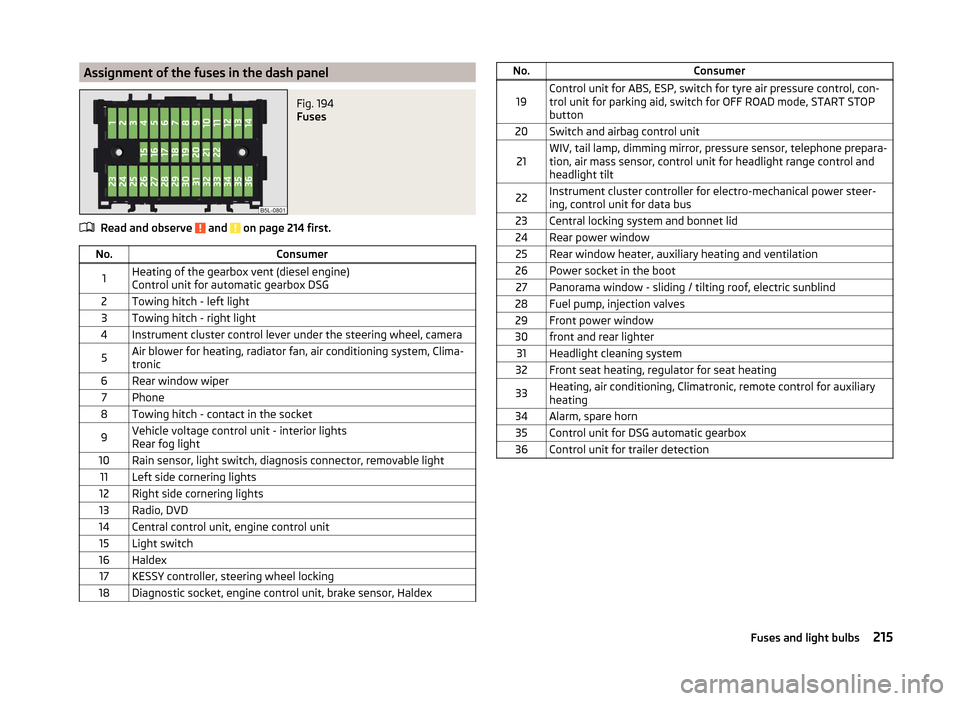
Assignment of the fuses in the dash panelFig. 194
Fuses
Read and observe and on page 214 first.
No.Consumer1Heating of the gearbox vent (diesel engine)
Control unit for automatic gearbox DSG2Towing hitch - left light3Towing hitch - right light4Instrument cluster control lever under the steering wheel, camera5Air blower for heating, radiator fan, air conditioning system, Clima-
tronic6Rear window wiper7Phone8Towing hitch - contact in the socket9Vehicle voltage control unit - interior lights
Rear fog light10Rain sensor, light switch, diagnosis connector, removable light11Left side cornering lights12Right side cornering lights13Radio, DVD14Central control unit, engine control unit15Light switch16Haldex17KESSY controller, steering wheel locking18Diagnostic socket, engine control unit, brake sensor, HaldexNo.Consumer19Control unit for ABS, ESP, switch for tyre air pressure control, con-
trol unit for parking aid, switch for OFF ROAD mode, START STOP button20Switch and airbag control unit21WIV, tail lamp, dimming mirror, pressure sensor, telephone prepara-
tion, air mass sensor, control unit for headlight range control and
headlight tilt22Instrument cluster controller for electro-mechanical power steer-
ing, control unit for data bus23Central locking system and bonnet lid24Rear power window25Rear window heater, auxiliary heating and ventilation26Power socket in the boot27Panorama window - sliding / tilting roof, electric sunblind28Fuel pump, injection valves29Front power window30front and rear lighter31Headlight cleaning system32Front seat heating, regulator for seat heating33Heating, air conditioning, Climatronic, remote control for auxiliary
heating34Alarm, spare horn35Control unit for DSG automatic gearbox36Control unit for trailer detection215Fuses and light bulbs
Page 220 of 248
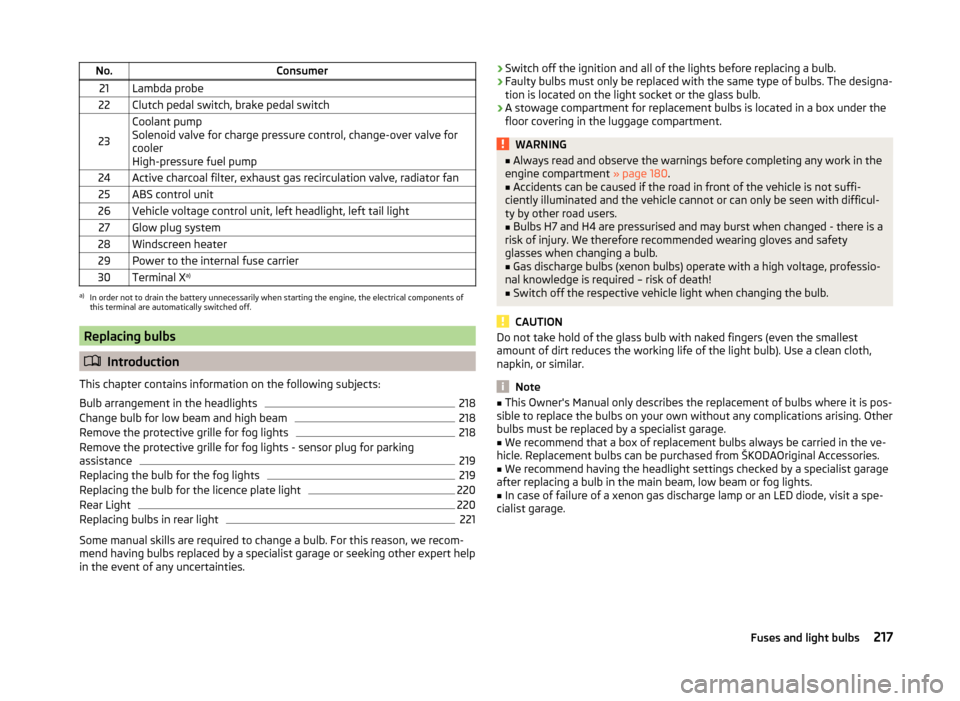
No.Consumer21Lambda probe22Clutch pedal switch, brake pedal switch
23
Coolant pump
Solenoid valve for charge pressure control, change-over valve for
cooler
High-pressure fuel pump24Active charcoal filter, exhaust gas recirculation valve, radiator fan25ABS control unit26Vehicle voltage control unit, left headlight, left tail light27Glow plug system28Windscreen heater29Power to the internal fuse carrier30Terminal X a)a)
In order not to drain the battery unnecessarily when starting the engine, the electrical components of
this terminal are automatically switched off.
Replacing bulbs
Introduction
This chapter contains information on the following subjects:
Bulb arrangement in the headlights
218
Change bulb for low beam and high beam
218
Remove the protective grille for fog lights
218
Remove the protective grille for fog lights - sensor plug for parking
assistance
219
Replacing the bulb for the fog lights
219
Replacing the bulb for the licence plate light
220
Rear Light
220
Replacing bulbs in rear light
221
Some manual skills are required to change a bulb. For this reason, we recom-
mend having bulbs replaced by a specialist garage or seeking other expert help
in the event of any uncertainties.
› Switch off the ignition and all of the lights before replacing a bulb.
› Faulty bulbs must only be replaced with the same type of bulbs. The designa-
tion is located on the light socket or the glass bulb.
› A stowage compartment for replacement bulbs is located in a box under the
floor covering in the luggage compartment.WARNING■ Always read and observe the warnings before completing any work in the
engine compartment » page 180.■
Accidents can be caused if the road in front of the vehicle is not suffi-
ciently illuminated and the vehicle cannot or can only be seen with difficul-
ty by other road users.
■
Bulbs H7 and H4 are pressurised and may burst when changed - there is a
risk of injury. We therefore recommended wearing gloves and safety
glasses when changing a bulb.
■
Gas discharge bulbs (xenon bulbs) operate with a high voltage, professio-
nal knowledge is required – risk of death!
■
Switch off the respective vehicle light when changing the bulb.
CAUTION
Do not take hold of the glass bulb with naked fingers (even the smallest
amount of dirt reduces the working life of the light bulb). Use a clean cloth,
napkin, or similar.
Note
■ This Owner's Manual only describes the replacement of bulbs where it is pos-
sible to replace the bulbs on your own without any complications arising. Other
bulbs must be replaced by a specialist garage.■
We recommend that a box of replacement bulbs always be carried in the ve-
hicle. Replacement bulbs can be purchased from ŠKODAOriginal Accessories.
■
We recommend having the headlight settings checked by a specialist garage
after replacing a bulb in the main beam, low beam or fog lights.
■
In case of failure of a xenon gas discharge lamp or an LED diode, visit a spe-
cialist garage.
217Fuses and light bulbs
Page 221 of 248
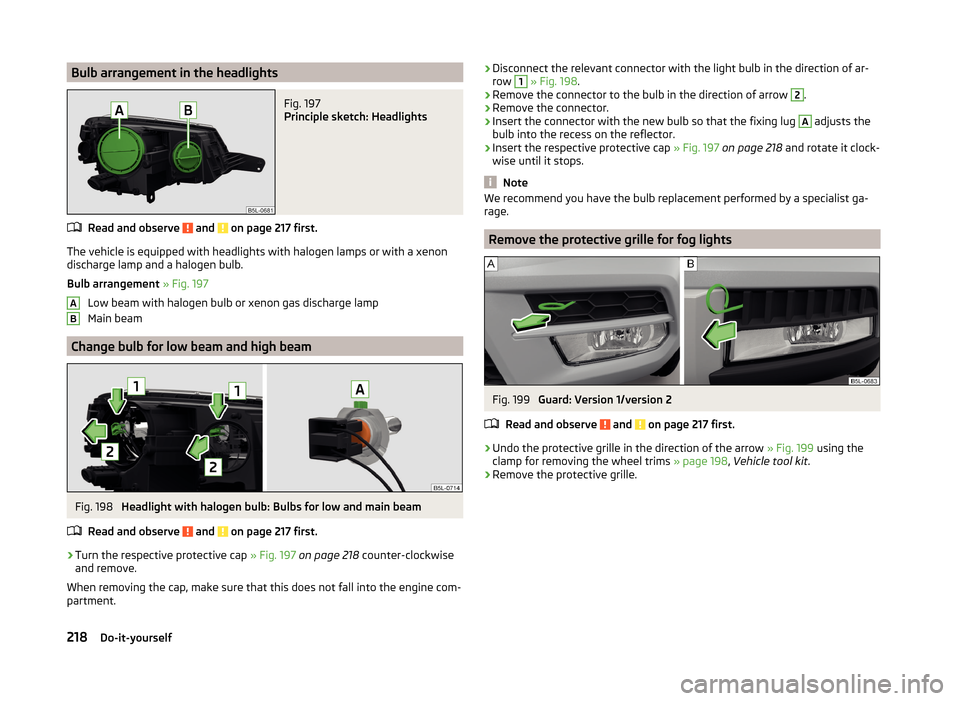
Bulb arrangement in the headlightsFig. 197
Principle sketch: Headlights
Read and observe and on page 217 first.
The vehicle is equipped with headlights with halogen lamps or with a xenon
discharge lamp and a halogen bulb.
Bulb arrangement » Fig. 197
Low beam with halogen bulb or xenon gas discharge lamp
Main beam
Change bulb for low beam and high beam
Fig. 198
Headlight with halogen bulb: Bulbs for low and main beam
Read and observe
and on page 217 first.
›
Turn the respective protective cap » Fig. 197 on page 218 counter-clockwise
and remove.
When removing the cap, make sure that this does not fall into the engine com-
partment.
AB› Disconnect the relevant connector with the light bulb in the direction of ar-
row 1 » Fig. 198 .›
Remove the connector to the bulb in the direction of arrow
2
.
›
Remove the connector.
›
Insert the connector with the new bulb so that the fixing lug
A
adjusts the
bulb into the recess on the reflector.
›
Insert the respective protective cap » Fig. 197 on page 218 and rotate it clock-
wise until it stops.
Note
We recommend you have the bulb replacement performed by a specialist ga-
rage.
Remove the protective grille for fog lights
Fig. 199
Guard: Version 1/version 2
Read and observe
and on page 217 first.
›
Undo the protective grille in the direction of the arrow » Fig. 199 using the
clamp for removing the wheel trims » page 198, Vehicle tool kit .
›
Remove the protective grille.
218Do-it-yourself
Page 224 of 248
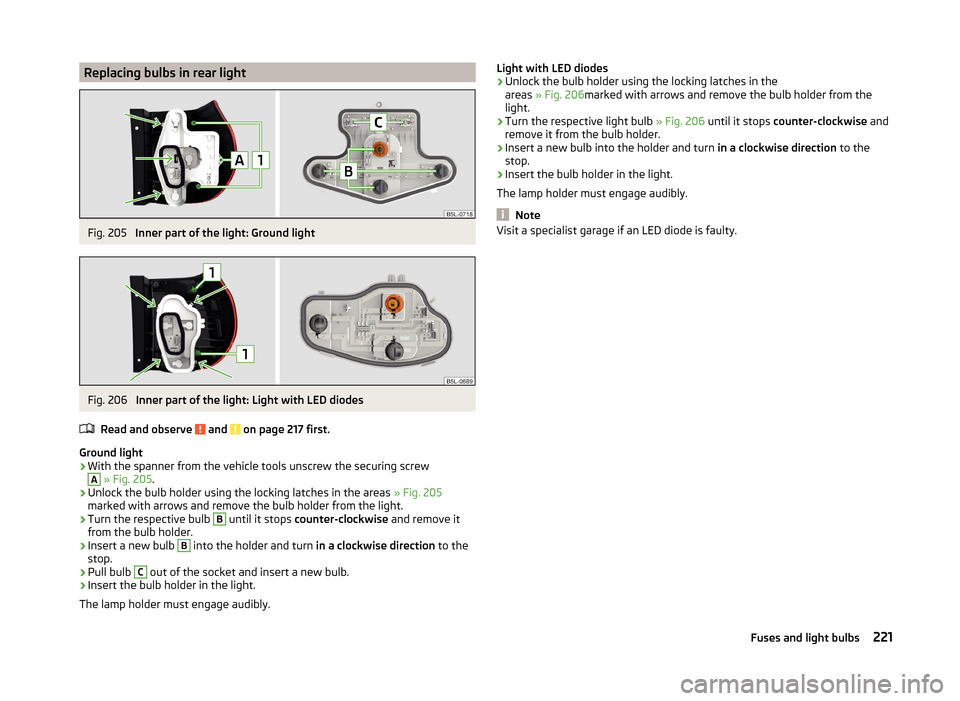
Replacing bulbs in rear lightFig. 205
Inner part of the light: Ground light
Fig. 206
Inner part of the light: Light with LED diodes
Read and observe
and on page 217 first.
Ground light
›
With the spanner from the vehicle tools unscrew the securing screw
A
» Fig. 205 .
›
Unlock the bulb holder using the locking latches in the areas » Fig. 205
marked with arrows and remove the bulb holder from the light.
›
Turn the respective bulb
B
until it stops counter-clockwise and remove it
from the bulb holder.
›
Insert a new bulb
B
into the holder and turn in a clockwise direction to the
stop.
›
Pull bulb
C
out of the socket and insert a new bulb.
›
Insert the bulb holder in the light.
The lamp holder must engage audibly.
Light with LED diodes›Unlock the bulb holder using the locking latches in the
areas » Fig. 206 marked with arrows and remove the bulb holder from the
light.›
Turn the respective light bulb » Fig. 206 until it stops counter-clockwise and
remove it from the bulb holder.
›
Insert a new bulb into the holder and turn in a clockwise direction to the
stop.
›
Insert the bulb holder in the light.
The lamp holder must engage audibly.
Note
Visit a specialist garage if an LED diode is faulty.221Fuses and light bulbs
Page 226 of 248

Operating weight and payload
Operating weight
This value represents the minimum operating weight without additional
weight-increasing equipment such as air conditioning system, spare wheel, or
trailer hitch.
The specified operating weight is for orientation purposes only.
The operating weight also contains the weight of the driver (75 kg), the weight
of the operating fluids, the tool kit, and a fuel tank filled to 90 % capacity.
Operating weight of the vehicle » page 226.
Payload
It is possible to calculate the approximate maximum payload from the differ-
ence between the permissible total weight and the operating weight.
The payload consists of the following weights.
› The weight of the passengers.
› The weight of all items of luggage and other loads.
› The weight of the roof, including the roof rack system.
› The weight of the equipment that is excluded from the operating weight.
› The trailer nose weight with trailer (max. 80 kg and 85 kg 1)
).
Note
If required, you can find out the precise weight of your vehicle at a specialist
garage.
Measurement of fuel consumption and CO 2 emissions according to
ECE Regulations and EU Directives
The data on fuel consumption and CO 2 emissions were not available at the
time of going to press.
The data on fuel consumption and CO 2 emissions are given on the ŠKODA
websites or in the sales and technical vehicle documentation.
The measurement of the intra-urban cycle begins with a cold start of the en-
gine. Afterwards urban driving is simulated.
In the extra-urban driving cycle, the vehicle is accelerated and decelerated in
all gears, corresponding to daily routine driving conditions. The driving speed
varies between 0 and 120 km/h.
The calculation of the combined fuel consumption considers a weighting of
about 37 % for the intra-urban cycle and 63 % for the extra-urban cycle.
Note
■ The fuel consumption and emission levels given on the ŠKODA websites or in
the commercial and technical vehicle documentation have been established in
accordance with rules and under conditions that are set out by legal or techni-
cal rules for the determination of operational and technical data of motor vehi-
cles.■
Depending on the extent of the equipment, the driving style, traffic condi-
tions, weather influences and vehicle condition, consumption values can in
practice result in fuel economy figures in the use of the vehicle that differ from
the fuel consumption values listed on the ŠKODA websites or in the commer-
cial and technical vehicle documentation.
1)
Applies to vehicles 4x4 with the 2.0 l/103 kW TDI CR and 2.0 L/125 kW TDI CR engine.
223Technical data
Page 228 of 248
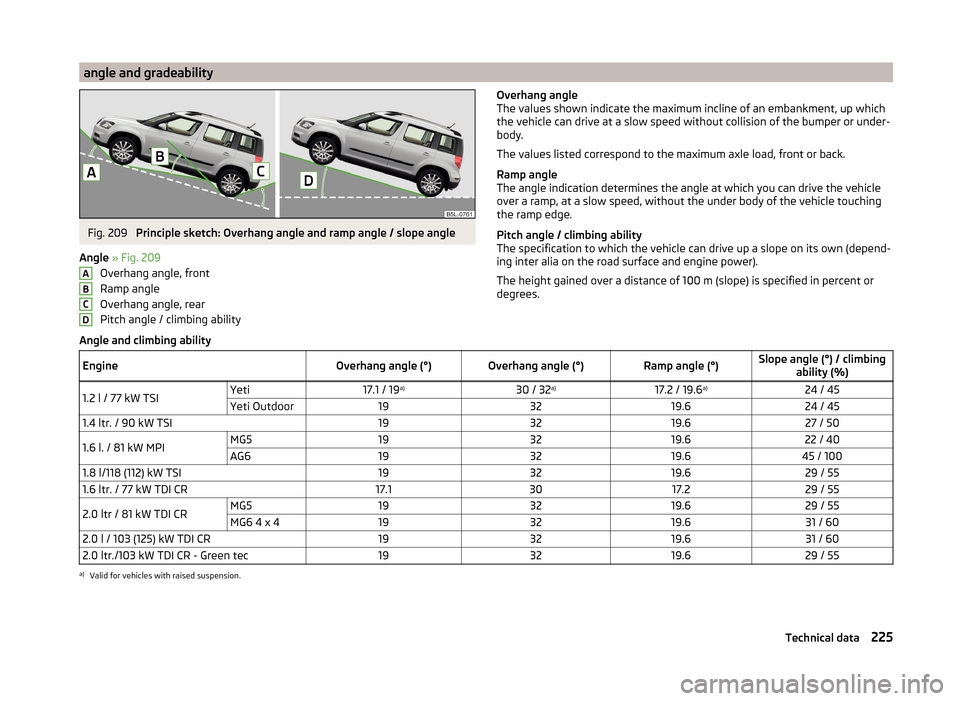
angle and gradeabilityFig. 209
Principle sketch: Overhang angle and ramp angle / slope angle
Angle » Fig. 209
Overhang angle, front
Ramp angle
Overhang angle, rear
Pitch angle / climbing ability
ABCDOverhang angle
The values shown indicate the maximum incline of an embankment, up which
the vehicle can drive at a slow speed without collision of the bumper or under-
body.
The values listed correspond to the maximum axle load, front or back.
Ramp angle
The angle indication determines the angle at which you can drive the vehicle
over a ramp, at a slow speed, without the under body of the vehicle touching
the ramp edge.
Pitch angle / climbing ability
The specification to which the vehicle can drive up a slope on its own (depend-
ing inter alia on the road surface and engine power).
The height gained over a distance of 100 m (slope) is specified in percent or degrees.Angle and climbing abilityEngineOverhang angle (°)Overhang angle (°)Ramp angle (°)Slope angle (°) / climbing ability (%)1.2 l / 77 kW TSIYeti17.1 / 19a)30 / 32a)17.2 / 19.6 a)24 / 45Yeti Outdoor193219.624 / 451.4 ltr. / 90 kW TSI193219.627 / 501.6 l. / 81 kW MPIMG5193219.622 / 40AG6193219.645 / 1001.8 l/118 (112) kW TSI193219.629 / 551.6 ltr. / 77 kW TDI CR17.13017.229 / 552.0 ltr / 81 kW TDI CRMG5193219.629 / 55MG6 4 x 4193219.631 / 602.0 l / 103 (125) kW TDI CR193219.631 / 602.0 ltr./103 kW TDI CR - Green tec193219.629 / 55a)
Valid for vehicles with raised suspension.
225Technical data